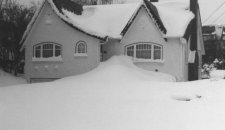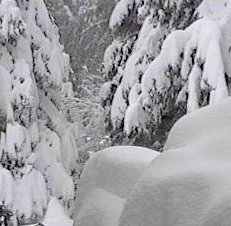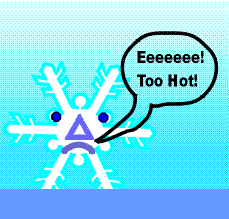 |
 |
| Home | Welcome | What's New | Site Map | Glossary | Weather Doctor Amazon Store | Book Store | Accolades | Email Us |
 | |||||||||
Weather Almanac for December 2000SOUNDS OF SILENT SNOWRecently, I had the opportunity to again view that classic film Dr Zhivago. I am always captured by the scenes depicting the depths of the Russian winters, particularly the house covered inside with frost and surrounded outside by extensive snow fields. So white, so silent.
What I remember of the "silent/snow" combination was the impact of snow -- falling and fallen -- on ambient sounds. My memory of the great snowstorm which blanketed Victoria during the year-end holiday week of 1996 is highlighted by the initial silence of the city. (In only a few days, we amassed around 124 cm (49 inches) of snow, including a 24-hour fall of 80 cm (31.5 inches) that completely shut down the city for several days.) 
When I turned in for the night that Saturday, I knew snow was falling and the accumulation was already heavy. Outside my window, the whine of tires filled the air as the last of the city buses and a few persistent autos tried to ascend the two hills from the col at the Quadra-Tolmie traffic light. But when I awoke at early light, the first sense I had was of silence. I remember actually humming to assure myself I had not gone deaf overnight. As I lay in bed I focused on the street but heard none of the usual sounds of traffic. The snow, which overnight had accumulated to over a metre, had stopped the city and its traffic dead in its tracks. Nothing, save a few hardy pedestrians, ventured out onto the street. With the sounds of the city activity paused, many east-end Victorians were keenly aware of the barking of a colony of seals that had taken winter residence on one of the many small rocky islands just offshore. I also keenly recall my days cross-country skiing in southern Ontario during a fluffy snowfall. The large, gently descending snowflakes covered all around me in a fluffy white, deadening the ambient sounds as I moved through the forest trail. The vocalizations of the winter birds muffled and close.
On the other hand, snow has its own distinct sounds as anyone who has spent much time outdoors during the winter can attest. Author and artist Eric Sloane wrote: "I used to think that snow was a silent action...." But later he changed his mind. "I have been more aware of the noise that snow makes as it falls, a sort of soft hiss...When it is very cold and the snowflakes are crisp, there is a metallic tinkle, probably the finest of sounds..."  Naturalist Edwin Way Teale remembered walking through a December snowfall: "Each time I pause, I hear the faint, fluttering sound of the flakes striking and sifting down among the tangles of the bare branches...." But not all of snow's sounds are so pleasant. Admiral Richard Byrd recalled in his book Alone, the story of his wintering on the Antarctic continent, the sounds of snow he heard were less enjoyable: "You become conscious of a general slithering movement on all sides. The air fills with tiny scraping and sliding and rustling sounds as the first loose crystals stir.... In a little while they are moving as solidly as an incoming tide, which creams over the ankles, then surges to the waist, and finally is at the throat." Those who travel across snow on foot, skies, or snowshoes know the many sounds of the snow cover. Perhaps the most terrifying sound is the low rumbling of an avalanche descending from a mountain slope, often conjoined with the sounds of destruction as it rips apart trees and other objects in its path. Snow underfoot speaks with a voice that differs with the temperature and conditions of the cover. Crusty snow cracks and crunches as you walk across, breaking the top layer. Very wet snow squishes and moans as you compact it with each step. And very cold, dry snow squeaks and whines. In Physics of the Air, William Humphrey tells us that when snow is in fine condition for snowballing, it is quiet. When snow is so cold it will not ball, "its voice is loud." The cause, he contends, is "the sudden breaks and slips of its dry crystals, that produce the familiar cold- weather creak and cry of the snow." Recently, a rather unexpected snow voice has come to light. Researchers have discovered that when a snowflake falls on a water surface, first it "plinks," and then it "screams" in a high- pitched wail as it melts. This nivean death-throe cry was discovered while they studied the different sounds precipitation makes while falling on a water surface. (This has led to techniques to measure precipitation over the open ocean.) Lawrence Crum of the University of Washington and his colleagues hear a definite "plop" when a raindrop strikes the water surface, followed milliseconds later by an acoustic oscillation from air bubbles generated by the drop's impact, giving a "ring" or "plink." With snow, there is no "plop" as the light flakes settle gently onto the water, but the following "plink" is there. This "plink" is next followed by the "scream" of melting. Both are emitted above the range of normal human hearing but well within that of many aquatic animals including porpoises and dolphins. The "scream" of melting is believed to be caused when air bubbles caught within the snowflake are released. (The typical snowflake is 90% air, 10% water.) The "scream" is high-frequency, from 50 to 200 kilohertz -- above human hearing but within the range of some aquatic species. According to Crum, noisy snowfalls can add up to 30 decibels of noise to the ambient high-frequency sounds, a difference in loudness similar to that between casual office conversation and a jackhammer. 
While a good snowstorm may be noisy to aquatic life (perhaps like a thunderstorm is to humans), it can be very annoying to wildlife biologists. One, David Daum uses sonar to count salmon swimming upstream in the fall. Under normal circumstances, he can easily distinguish between individual fish against a contrasting background on his viewing screen. When it snows, however, Daum laments, "the whole thing is black, like someone shook pepper on the screen." While I will never actually hear a snowflake's final cry, I don't think I will ever again watch snowflakes alight on the water in quite the same way. In my mind, I will "hear" their "screams" as they are pulled back from the crystal life and into the liquid state. Learn More About Snow From These Relevant Books
|
|||||||||
 |
To Purchase Notecard, |
Now Available! Order Today! | |
 |
 |
NEW! Now |
The BC Weather Book: |


